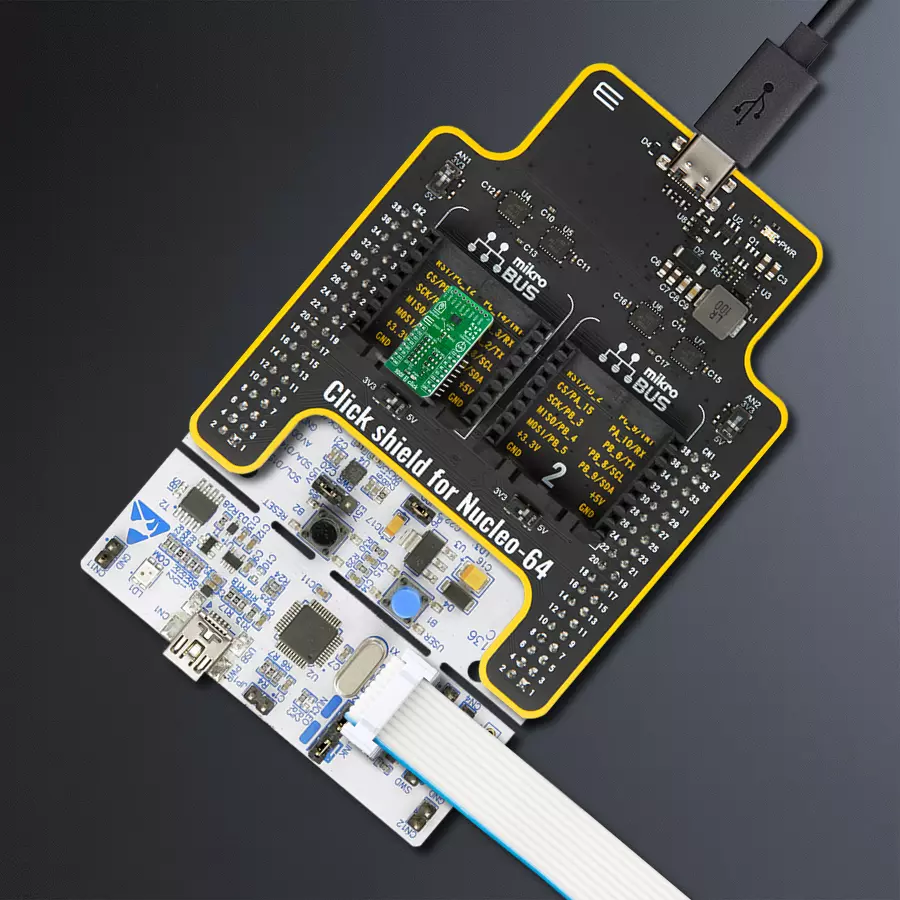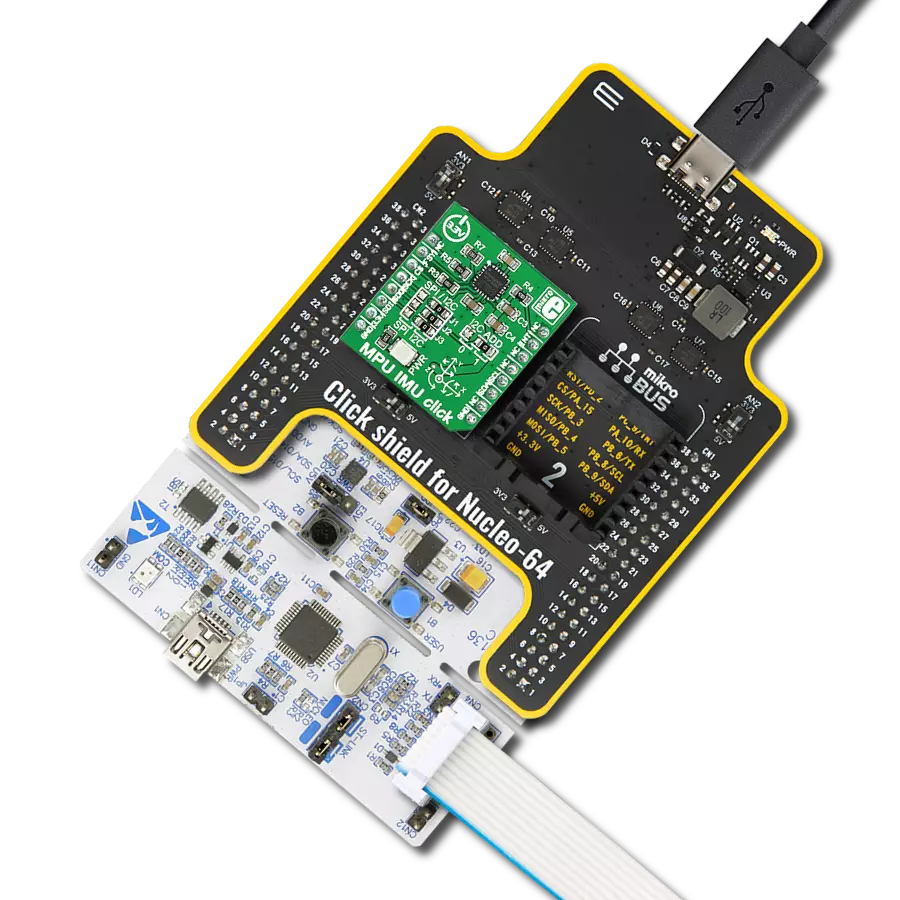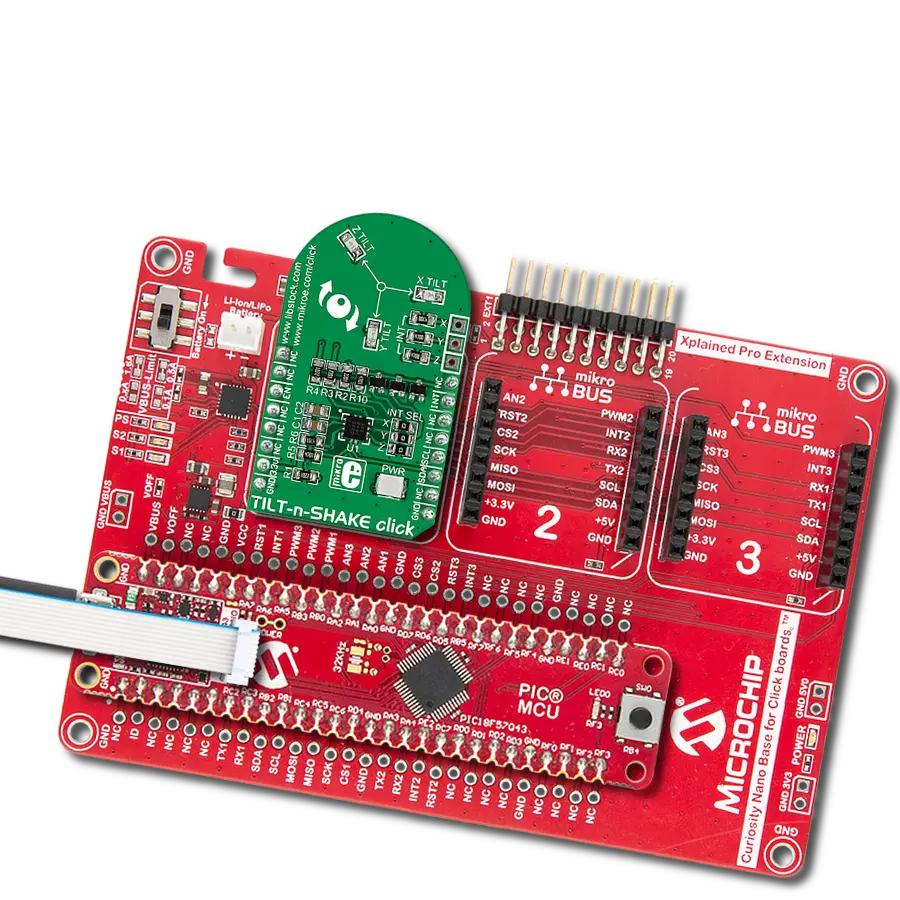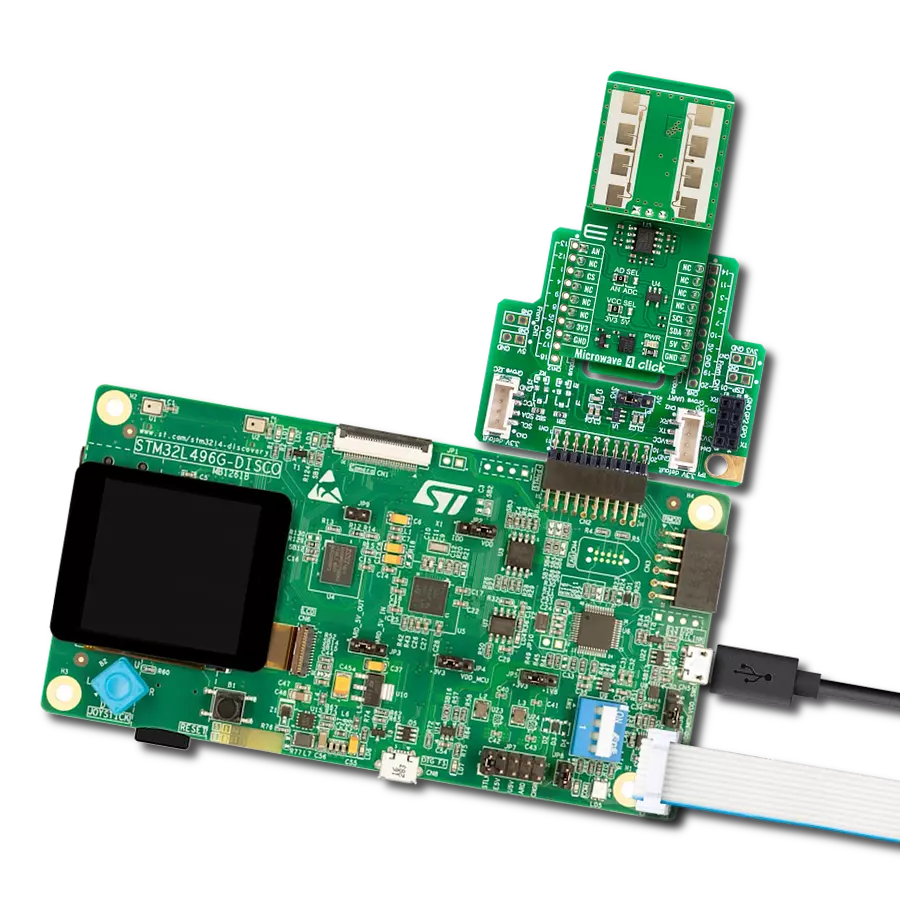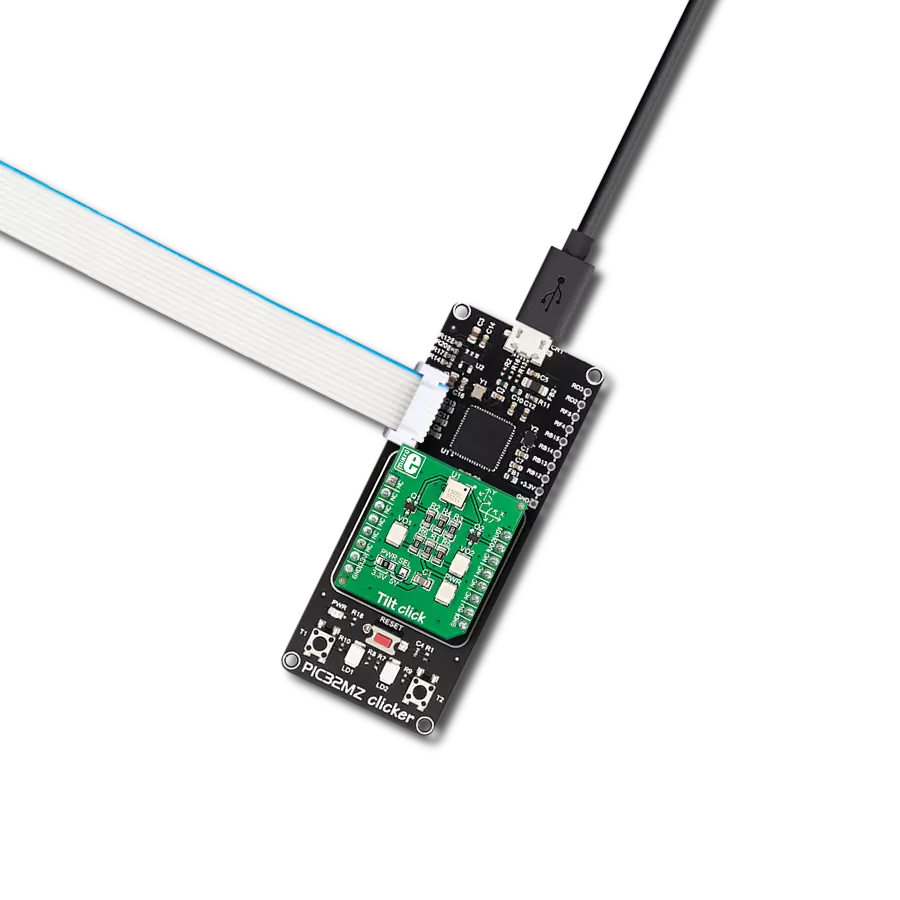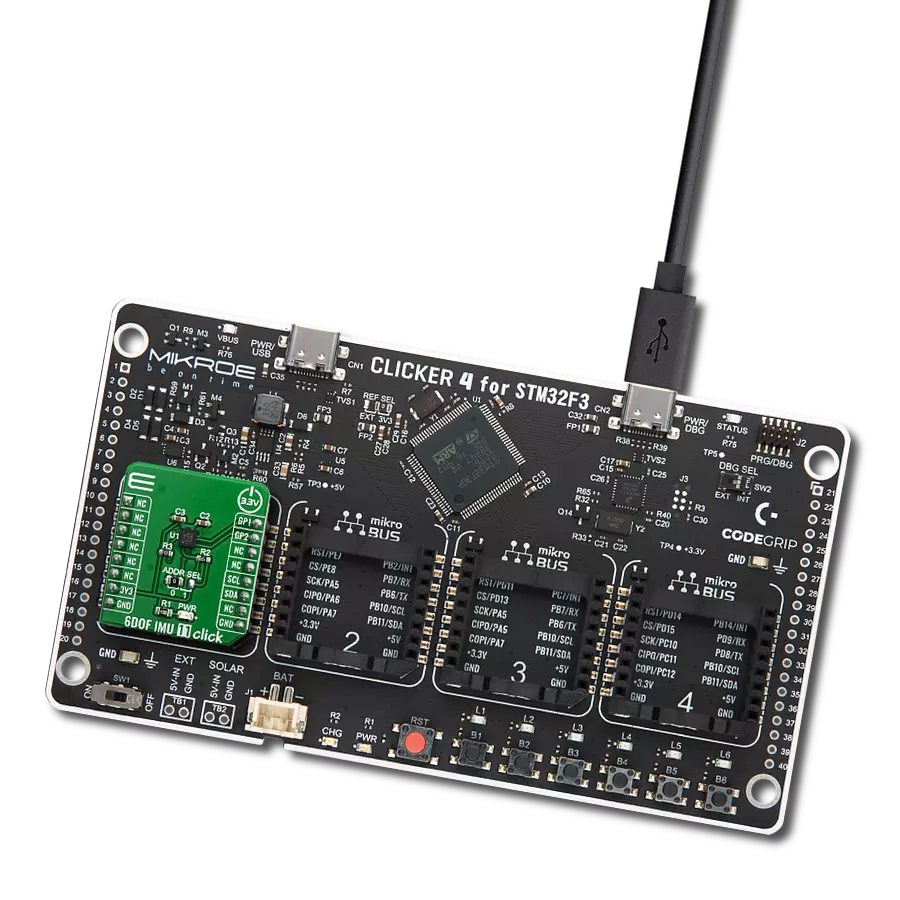Empower your devices with the ability to understand and respond to natural human movements, making interactions intuitive and enriching thanks to our advanced 9-axis sensing technology
A
A
Hardware Overview
How does it work?
9DOF 3 Click is based on the BMX055, an integrated 9-axis sensor for detecting movements, rotations, and magnetic heading from Bosch Sensortec. It comprises the full functionality of a triaxial, low-g acceleration sensor, a triaxial angular rate sensor, and a triaxial geomagnetic sensor. The BMX055 senses orientation, tilt motion, acceleration, rotation, shock, vibration, and heading in cell phones, handhelds, computer peripherals, man-machine interfaces, virtual reality features, and game controllers. The BMX055 allows accurate measurements of angular rate, acceleration, and geomagnetic fields in 3 perpendicular axes within one device. The programmable measurement ranges are ±2g, ±4g, ±8g, 16g for accelerometer, ±125°/s, ±250°/s, ±500°/s, ±1000°/s, ±2000°/s for gyroscope and 1300µT (x,y), 2500µT (z) for the magnetometer. The smallest to be distinguished magnitude from the measured
value, or short for resolution, is 0.98mg, 0.004°/s, and 0.3µT for the accelerometer, gyroscope, and magnetometer, respectively. Several power modes are configurable for each sensor intended for low-power applications and power saving. The data from sensors are acquired via a selected digital interface, either SPI or I2C, by reading the addresses directly. Featured IC possesses a 16-bit gyroscope, 12-bit accelerometer, and a full-performance geomagnetic sensor that provides data in 2's complement representation. Measured data compensation and calibration are also included as an on-chip feature and a temperature sensor for reducing temperature fluctuations on sensitive components. 9DOF 3 Click supports two serial digital interface protocols for communication as a peripheral with a host device: SPI and I2C. The active interface is selected by soldering the SMD jumpers to an appropriate
position. The I2C address can also be configured by an SMD jumper when the Click board™ is operated in the I2C mode. The SMD jumpers labeled ADDR SEL are used to set the I2C address of the BMX055. The BMX055 module supports four interrupt pins for each sensor: Accel_INT, Gyro_INT, Mag_INT, and DRDY. The sensor interrupt is selectable via one cross-shaped jumper selection and routed to the Mikrobus INT pin. There is also a header on top of the click with the breakout of all available sensor interrupt pins. This Click board™ can be operated only with a 3.3V logic voltage level. The board must perform appropriate logic voltage level conversion before using MCUs with different logic levels. Also, it comes equipped with a library containing functions and an example code that can be used, as a reference, for further development.
Features overview
Development board
Nucleo-64 with STM32F091RC MCU offers a cost-effective and adaptable platform for developers to explore new ideas and prototype their designs. This board harnesses the versatility of the STM32 microcontroller, enabling users to select the optimal balance of performance and power consumption for their projects. It accommodates the STM32 microcontroller in the LQFP64 package and includes essential components such as a user LED, which doubles as an ARDUINO® signal, alongside user and reset push-buttons, and a 32.768kHz crystal oscillator for precise timing operations. Designed with expansion and flexibility in mind, the Nucleo-64 board features an ARDUINO® Uno V3 expansion connector and ST morpho extension pin
headers, granting complete access to the STM32's I/Os for comprehensive project integration. Power supply options are adaptable, supporting ST-LINK USB VBUS or external power sources, ensuring adaptability in various development environments. The board also has an on-board ST-LINK debugger/programmer with USB re-enumeration capability, simplifying the programming and debugging process. Moreover, the board is designed to simplify advanced development with its external SMPS for efficient Vcore logic supply, support for USB Device full speed or USB SNK/UFP full speed, and built-in cryptographic features, enhancing both the power efficiency and security of projects. Additional connectivity is
provided through dedicated connectors for external SMPS experimentation, a USB connector for the ST-LINK, and a MIPI® debug connector, expanding the possibilities for hardware interfacing and experimentation. Developers will find extensive support through comprehensive free software libraries and examples, courtesy of the STM32Cube MCU Package. This, combined with compatibility with a wide array of Integrated Development Environments (IDEs), including IAR Embedded Workbench®, MDK-ARM, and STM32CubeIDE, ensures a smooth and efficient development experience, allowing users to fully leverage the capabilities of the Nucleo-64 board in their projects.
Microcontroller Overview
MCU Card / MCU
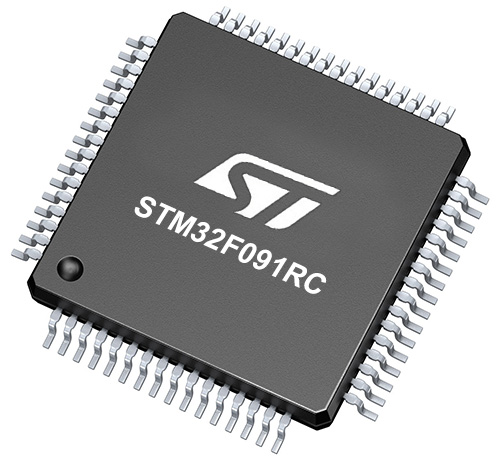
Architecture
ARM Cortex-M0
MCU Memory (KB)
256
Silicon Vendor
STMicroelectronics
Pin count
64
RAM (Bytes)
32768
You complete me!
Accessories
Click Shield for Nucleo-64 comes equipped with two proprietary mikroBUS™ sockets, allowing all the Click board™ devices to be interfaced with the STM32 Nucleo-64 board with no effort. This way, Mikroe allows its users to add any functionality from our ever-growing range of Click boards™, such as WiFi, GSM, GPS, Bluetooth, ZigBee, environmental sensors, LEDs, speech recognition, motor control, movement sensors, and many more. More than 1537 Click boards™, which can be stacked and integrated, are at your disposal. The STM32 Nucleo-64 boards are based on the microcontrollers in 64-pin packages, a 32-bit MCU with an ARM Cortex M4 processor operating at 84MHz, 512Kb Flash, and 96KB SRAM, divided into two regions where the top section represents the ST-Link/V2 debugger and programmer while the bottom section of the board is an actual development board. These boards are controlled and powered conveniently through a USB connection to program and efficiently debug the Nucleo-64 board out of the box, with an additional USB cable connected to the USB mini port on the board. Most of the STM32 microcontroller pins are brought to the IO pins on the left and right edge of the board, which are then connected to two existing mikroBUS™ sockets. This Click Shield also has several switches that perform functions such as selecting the logic levels of analog signals on mikroBUS™ sockets and selecting logic voltage levels of the mikroBUS™ sockets themselves. Besides, the user is offered the possibility of using any Click board™ with the help of existing bidirectional level-shifting voltage translators, regardless of whether the Click board™ operates at a 3.3V or 5V logic voltage level. Once you connect the STM32 Nucleo-64 board with our Click Shield for Nucleo-64, you can access hundreds of Click boards™, working with 3.3V or 5V logic voltage levels.
Used MCU Pins
mikroBUS™ mapper
Take a closer look
Click board™ Schematic

Step by step
Project assembly
Track your results in real time
Application Output
1. Application Output - In Debug mode, the 'Application Output' window enables real-time data monitoring, offering direct insight into execution results. Ensure proper data display by configuring the environment correctly using the provided tutorial.

2. UART Terminal - Use the UART Terminal to monitor data transmission via a USB to UART converter, allowing direct communication between the Click board™ and your development system. Configure the baud rate and other serial settings according to your project's requirements to ensure proper functionality. For step-by-step setup instructions, refer to the provided tutorial.

3. Plot Output - The Plot feature offers a powerful way to visualize real-time sensor data, enabling trend analysis, debugging, and comparison of multiple data points. To set it up correctly, follow the provided tutorial, which includes a step-by-step example of using the Plot feature to display Click board™ readings. To use the Plot feature in your code, use the function: plot(*insert_graph_name*, variable_name);. This is a general format, and it is up to the user to replace 'insert_graph_name' with the actual graph name and 'variable_name' with the parameter to be displayed.

Software Support
Library Description
This library contains API for 9DOF 3 Click driver.
Key functions:
c9dof3_check_communication- This function check device ID for accelerometer, gyroscope and magnetometerc9dof3_get_data- This function read Accel, Gyro and Mag X-axis, Y-axis data and Z-axis datac9dof3_generic_read- This function reads data from the desired register
Open Source
Code example
The complete application code and a ready-to-use project are available through the NECTO Studio Package Manager for direct installation in the NECTO Studio. The application code can also be found on the MIKROE GitHub account.
/*!
* \file
* \brief 9Dof3 Click example
*
* # Description
* This Click introduces a small-scale absolute orientation sensor in the class of low-noise
* 9-axis measurement units. It comprises the full functionality of a triaxial, low-g acceleration
* sensor, a triaxial angular rate sensor and a triaxial geomagnetic sensor. All three sensor
* components can be operated and addressed independently from each other. 9DOF 3 Click offers
* both SPI and I2C digital interfaces
*
* The demo application is composed of two sections :
*
* ## Application Init
* Initialization driver enables - I2C or SPI, check communication,
* set default configuration for accelerometer, gyroscope and magnetometer, also write log.
*
* ## Application Task
* This is an example which demonstrates the use of 9DOF 3 Click board.
* Measures and displays Accel, Gyroscope and Magnetometer values for X-axis, Y-axis and Z-axis.
* Results are being sent to the Usart Terminal where you can track their changes.
* All data logs write on USB uart changes for every 1 sec.
*
* \author MikroE Team
*
*/
// ------------------------------------------------------------------- INCLUDES
#include "board.h"
#include "log.h"
#include "c9dof3.h"
// ------------------------------------------------------------------ VARIABLES
static c9dof3_t c9dof3;
static log_t logger;
c9dof3_accel_t accel_data;
c9dof3_gyro_t gyro_data;
c9dof3_mag_t mag_data;
// ------------------------------------------------------ APPLICATION FUNCTIONS
void application_init ( void )
{
log_cfg_t log_cfg;
c9dof3_cfg_t cfg;
/**
* Logger initialization.
* Default baud rate: 115200
* Default log level: LOG_LEVEL_DEBUG
* @note If USB_UART_RX and USB_UART_TX
* are defined as HAL_PIN_NC, you will
* need to define them manually for log to work.
* See @b LOG_MAP_USB_UART macro definition for detailed explanation.
*/
LOG_MAP_USB_UART( log_cfg );
log_init( &logger, &log_cfg );
log_info( &logger, "---- Application Init ----" );
// Click initialization.
c9dof3_cfg_setup( &cfg );
C9DOF3_MAP_MIKROBUS( cfg, MIKROBUS_1 );
c9dof3_init( &c9dof3, &cfg );
Delay_ms ( 100 );
if ( c9dof3_check_communication( &c9dof3 ) == ( C9DOF3_ACC_COMM_SUCCESS |
C9DOF3_GYRO_COMM_SUCCESS |
C9DOF3_MAG_COMM_SUCCESS ) )
{
log_printf( &logger, " Communication OK \r\n" );
}
else
{
log_printf( &logger, " Communication ERROR \r\n" );
log_printf( &logger, " Reset the device \r\n" );
log_printf( &logger, "-------------------------\r\n" );
for ( ; ; );
}
log_printf( &logger, "-------------------------\r\n" );
c9dof3_default_cfg( &c9dof3 );
Delay_ms ( 100 );
}
void application_task ( void )
{
c9dof3_get_data ( &c9dof3, &accel_data, &gyro_data, &mag_data );
log_printf( &logger, " Accel X: %d | Gyro X: %d | Mag X: %d\r\n", accel_data.x, gyro_data.x, mag_data.x );
log_printf( &logger, " Accel Y: %d | Gyro Y: %d | Mag Y: %d\r\n", accel_data.y, gyro_data.y, mag_data.y );
log_printf( &logger, " Accel Z: %d | Gyro Z: %d | Mag Z: %d\r\n", accel_data.z, gyro_data.z, mag_data.z );
log_printf( &logger, "------------------------------------------\r\n" );
Delay_ms ( 1000 );
}
int main ( void )
{
/* Do not remove this line or clock might not be set correctly. */
#ifdef PREINIT_SUPPORTED
preinit();
#endif
application_init( );
for ( ; ; )
{
application_task( );
}
return 0;
}
// ------------------------------------------------------------------------ END
Additional Support
Resources
Category:Motion







